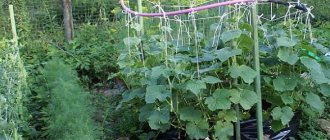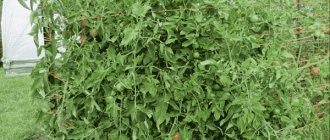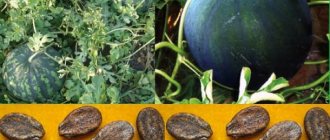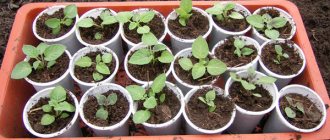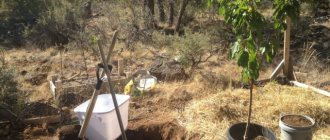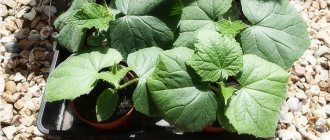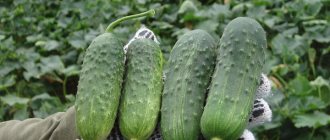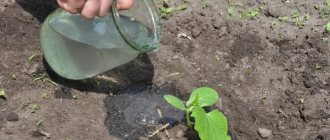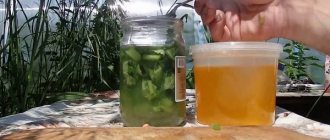Is it possible to grow cucumbers in a greenhouse in winter?
It is certainly possible to grow a vegetable such as a cucumber in a greenhouse in winter. This allows you to eat the freshest vegetables all year round.
It is worth recalling that cucumbers require special care in the greenhouse. They are very demanding of warmth and regular watering. During the season in question, cucumbers produce fruit depending on their variety. Environmental conditions will not affect what is happening in the greenhouse if the desired temperature regime is maintained.
Planting and care
When growing cucumber crops in winter, it is convenient to plant them directly in the ground or as seedlings. When planting seedlings, there is an advantage: you can choose the strongest ones among all the seedlings. At the stage of appearance of 2-3 leaves, fertilizing with mineral compounds is carried out and after a few days the strongest seedlings are planted in the greenhouse.
Correct fit and optimal mode
The rules for growing cucumbers in a greenhouse in winter require heated soil and prepared holes for planting cucumbers, spilled with water and absorbing all the moisture. The seedlings are removed from the container along with the soil and placed in the hole at the level of the cotyledon leaves, sprinkled with soil. After planting, you should create the required microclimate for the vegetable crop according to the scheme shown in the table:
| Options | Optimal performance | Limit values |
| Daytime temperature | 23°С - 25°С | Below 8°C and above 37°C |
| Night temperature | 17°С - 18°С | Below 8°C and above 37°C |
| Ground temperature | 20°С - 22°С | Below 15°C and above 35°C |
| Humidity | 75% — 80% | Below 40% |
| Illumination | 10.0 thousand - 15.0 thousand lux | Long time 2.5 thousand lux |
What should a winter greenhouse for cucumbers be like?
How you can achieve good results in greenhouse design:
- ensuring a well-designed and located greenhouse;
- availability of high-quality heating;
- moisture level adjustment;
- light from additional sources;
- loosened soil.
Such conditions for growing cucumbers can be provided in a greenhouse made of polycarbonate or glass material in winter. Greenhouses made of film are not the most suitable for use in winter, as they have low strength: in conditions of heavy snowfall, the film can sag, and snow will linger on it and lead to the collapse of the structure.
Greenhouse design
In a ratio of one to two, the temperature outside the greenhouse does not particularly affect the temperature inside it. When creating winter greenhouse conditions, gardeners often use polycarbonate and glass. And if a greenhouse is made in the southern part of the country with low temperature fluctuations, then it is possible to use thick plastic film.
The primary condition is to protect the crop from exposure to cold and transmit as much sunlight as possible. The greenhouse cover is often glass or polycarbonate, the frame structure is made of wood or metal. The slope of the wall on the south side in a greenhouse of this type depends on the inclination of the sun above the horizon in the area. The optimal case is when at noon the rays penetrate through the glass of the greenhouse at a slope of 90 degrees.
The beds in the greenhouse are inclined or stepped. This allows the sun to illuminate the plant without obstacles and warm it well. Paint the back wall of the greenhouse white or line it with foil, since when reflected from it, the sun will illuminate the plants from the back.
It will be convenient to enter the greenhouse through the vestibule. It will protect the cucumbers from the cold. There you can put a water tank and install heating. Ventilation in the winter version of the greenhouse does not need to be done through a window, since cucumbers do not need drafts at all. The best option is the supply and exhaust option and the use of plastic pipes.
Heating
An overly dry atmosphere around is contraindicated for cucumbers; therefore, heating devices should not be installed in greenhouse structures, as they dry out the air. Here, the best solution would be water-based heating: the ground will be heated using pipes, and the air using radiators.
To heat the coolant, you can use a special boiler or stove. The first option is more suitable due to better results in terms of combustion degree and level of automation. The boiler can be gas, electric or solid fuel. Power must be taken into account using the formula: one kilowatt per approximately ten square meters.
Greenhouse lighting
In winter, cucumbers require lighting. It is easy to solve the problem with additional lighting if you use special lamps. However, it is important to observe several parameters, namely the degree of illumination and color temperature.
Plants need daylight or as close to it as possible.
Such lighting should have a color temperature of five thousand kelvins. Sources include fluorescent, mercury and metal halide lamps. During the growth stage, the best solution would be to use lamps with a cooler shade (about six and a half thousand kelvins), and during flowering and fruiting - with a warmer shade (approximately four thousand kelvins). In such conditions, the plants will remain strong and with good ovaries. Important! The light output of fluorescent lamps is not the best - you will need much more of them for the same area.
But they are much cheaper in cost. Special LED lamps for plants are also suitable for lighting. LEDs have a red-blue spectrum, which accelerates growth and improves fruiting. Long-term exposure to such a spectrum is extremely harmful to human vision, so you need to work in a greenhouse in natural light.
Requirements for such a greenhouse
A winter greenhouse for cucumbers must meet the following requirements:
- Solid concrete foundation or structures buried in the ground. In this case, the soil layer will perform an additional heating function.
- Metal frame with anti-corrosion coating, polycarbonate. Such greenhouses are not cheap, but they will quickly pay for themselves.
- Vents for ventilation, curtains to protect from too bright sun.
- Drip irrigation system.
- Ability to control indoor humidity.
- Lighting. You need bright light bulbs with height adjustment.
- Heating. Use electric boilers or wood stoves. The beds can also be covered with a layer of humus and straw, and roofing material can be installed around the place where cucumbers are grown.
- You can plant cucumbers not in the ground, but in racks in several layers at once - this will save space.
Soil work
It is necessary to complete the soil preparation in such a time as to sow in the last days of September and obtain harvests by the beginning of January. Next time you can sow by the end of the first month of winter. If the greenhouse is new, then it is necessary to prepare a mixture rich in organic elements, disinfect the soil, fertilize and dig it to a depth of approximately thirty centimeters.
Replacement and disinfection of soil
If the greenhouse is no longer new, then the gardener should remove the top layer of soil and replace it (about fifteen centimeters). The mixture may consist of humus and forest soil (it should be mixed in a one to one ratio). In peat-rich areas, high-moor peat is taken as the base and garden soil, not treated with herbicides and other chemicals, and humus are added to it in a ratio of 50:20:30%. The mixture must be carefully shoveled and the beds filled with it.
The next stage of preparation is soil disinfection. The most optimal method is one in which you need to spill the substrate with a solution of copper sulfate (concentration - from five to seven percent).
Application of fertilizers and special substances
The soil must be fed with mineral-based fertilizers, for example, kemira, nitrophoska. It is necessary to dig up the soil thirty centimeters. At the time of sowing, the soil should have a temperature of about twenty degrees above zero. About a week before sowing, to enrich the soil with beneficial microflora and eliminate negative elements, you need to add a solution of “Ekomik Urozhayny” or “Baikal EM-1” in a ratio of one hundred millimeters of substance per liter of water. Seeds are sown at the end of October or seedlings are planted in the last ten days of October.
Arrangement of beds
So, when preparing the soil for winter use, first of all, remove the top layer (10-15 cm) and replace it with fresh one. The soil mixture can be prepared using forest soil instead of garden soil, and humus can be replaced with turf soil.
In areas rich in peat bogs, when preparing the mixture, peat is used, of course, and garden soil and humus are added. Any of the prepared soils must be mixed well and the beds filled with them.
Watering mode
If you notice that the leaves begin to wither, this means that there is insufficient air humidity in the room. In such cases, it is recommended to irrigate using the sprinkling method and additionally irrigate the bushes with special sprayers. If it happens that the roots of the plants are visible above the soil surface, then hilling should be carried out. It is preferable to water in the morning and evening, because in the daytime, when the sun is very hot through the glass, you can burn the plants. This article will tell you how to water cucumbers correctly.
Yellowing of cucumber leaves in a greenhouse indicates insufficient air humidity
Top dressing
The next stage will be fertilization and disinfection. To fertilize the soil in greenhouses, mineral fertilizers such as nitrophoska and kemira are used. They are applied at the rate of 40-50 g per square meter, and then they must be dug to a depth of 25-30 cm. 7-9 days before sowing seeds or planting ready-made cucumber seedlings, biological products (like Baikal M1) are added to the soil at the rate of 100 ml of the drug for 1 liter of water.
To obtain a large yield, add mineral and organic fertilizers to the soil
The beneficial microorganisms of this preparation have a detrimental effect on the negative microflora of the soil and at the same time saturate it with beneficial ones.
Disease Prevention
Due to fluctuations in humidity in the greenhouse, favorable conditions arise for the development of pathogens. In this regard, it is necessary to choose varieties that are resistant to fungal rot and various types of infections.
Garter
To prevent high planting density, it is necessary to mold the plants. Hybrid varieties with limited branching can significantly facilitate this task. They produce almost no side branches at all, which means that all the growth force is directed to the development of the main stem. Therefore, they practically do not need to be molded; it is enough to just tie them vertically to the supports. Read how to properly tie cucumbers in greenhouses here. The best seeds for growing cucumbers in a greenhouse in winter. The following varieties and hybrids can be included (F-1 marking of hybrids): “Moscow Nights F1”, Ladoga F1, Northern Lights F1, Phoenix Plus, Olympics F1, Amur F1, Cheetah F1, Dynamit F1 and varieties Russian, Domashny, Marfinsky, Willow, Relay race.
Cucumber varieties for winter cultivation
The best varieties are hybrids, since they do not need pollinators, and they also develop well in low amounts of light. The table shows the most popular winter varieties of cucumbers:
| Hybrid | Description |
| Hummingbird F1 | Productivity – nine kilograms per square meter; ripens on the fortieth day. The suitable climate type is moderate. The fruits are crispy and not bitter. The shape is a narrowed cylinder. |
| Zozulya F1 | It is necessary to plant two or three shrubs per 1 m2. The yield is approximately twenty kilograms per square meter, in the first month - up to sixteen kilograms per square meter. |
| Picnic F1 | It bears fruit on the forty-eighth day after germination, the flowering type is female. Suitable soil is open and protected, film shelters are allowed. The plant is medium-sized, almost without branches. Ovaries of the main shoot - up to ten pieces. The fruit is up to twelve centimeters long, weighs about one hundred grams, and has white thorns. Productivity is up to seven kilograms. |
Seed preparation
It is necessary to sort the seeds, removing bad and damaged ones. Next, you should place them in salted water and remove those that float to the surface and wash them off the salt. Gardeners select the disinfecting solution personally and purely individually. In order to disinfect seeds, diluted boric acid or potassium permanganate is good. Treated seeds can be kept in the refrigerator for about a week, placed on regularly moistened gauze, and used for planting.
Agricultural technology for growing cucumbers in a winter greenhouse
In a greenhouse, it is better to grow cucumbers using the seedling method, since thanks to it the plants grow strong and the harvest time is reduced. If the gardener uses seeds from the store, then he does not need to carry out pre-sowing preparation.
Sowing seeds and planting seedlings
The frequency of sowing seeds or seedlings directly depends on the variety of cucumbers and is approximately two or four bushes per square meter, so that there is sufficient free space for growth and high-quality light distribution. When planting in rows, leave about forty-five centimeters between seedlings. Upon completion of planting, it is necessary to install wire trellises and tie twine or a specialized mesh to them.
Temperature conditions
Throughout the entire period of cucumber growth, the soil temperature should be + 15-18 °C. If the temperature drops, infection of the roots by fungus will increase. During the day, the temperature should be between twenty-three and twenty-five degrees Celsius, at night - from eighteen to twenty degrees.
Watering and air humidity
Cucumbers love a moist environment and need systematic watering. Changes in soil moisture conditions are unacceptable. From the moment of planting until the moment of flowering, it is necessary to water the plant in moderate quantities in order to prevent the formation of a large leaf surface. Watering should be done after about five days. From the moment of general flowering, watering should be increased. It should be done up to three times every seven days.
When fruiting, the water rate must be increased to ten liters per square meter. Plants should be watered with heated, settled water, the temperature of which is close to the temperature of the soil (about twenty degrees above zero Celsius).
Important!
It is necessary to water along the furrows between the rows so that the soil in the immediate surroundings of the bush is dry, since this principle of watering reduces rotting of the roots. And wilting of the leaves is a sign of increased air aridity, which means the need for urgent watering of the plant or at least spraying it.
If the roots are exposed, you should hill up the plant or add a soil mixture. It is better to water the plants in the morning or evening, so as not to burn them at high solstice. When the temperature reaches twenty-five degrees Celsius, the greenhouse must be ventilated, but drafts should not be allowed.
Feeding
For example, chicken manure can be used as fertilizer (in a ratio of one to fifteen). In order to enrich the infusion with microelements, you need to add wood ash (one glass per bucket). Stir and let brew for 2-3 days.
For prevention, it is worth spraying the plants with Fitosporin three times every fifteen days, which prevents the appearance of fungus.
You may be interested in:
When to sow cucumber seeds for seedlings in 2021 for a greenhouse It doesn’t matter in what conditions the cucumbers will grow, the seedlings need to be prepared on time. If you sow the seeds earlier or later...Read more...
Cucumbers all year round: growing technology
It is best to sow cucumbers in peat pots. In order for the harvest to ripen by January, the seeds must be immersed in the ground in early September.
Planting cucumbers is done using the following technology:
- 2 seeds are immersed in a peat pot to a depth of 2 cm.
- The soil is moistened with a spray bottle. Alternatively, you can place a damp cloth over the pot.
- The top of the pot is covered with glass.
- The temperature for germination is 25 degrees, then it can be lowered to 15 during the day and 12 at night.
To ensure a constant harvest, seeds can be sown every 2 weeks.
After a month from the date of planting, the germinated seedlings are transplanted into a greenhouse. Remember that the distance between plants is 20-30 cm, between rows - 90 cm.
Features of care after transplantation
Cucumbers need to be fed once every fourteen days, adding fertilizers on a mineral basis, and then on an organic one. We must not forget about maintaining high humidity. To ensure such conditions, the floor and heating pipes must be constantly watered. Open tanks should be placed inside the greenhouse, which will be “responsible” for humidifying the air, settling and heating the water.
Before flowering, plants need to be watered twice every seven days, and after that - more abundantly and more often. Do not forget about the elasticity and juiciness of the leaves. Withered, dry leaves are a signal of extreme lack of moisture. Young plants should be lit with low hanging lights and then the lights should be raised as the plants get larger. The temperature during the day should be above twenty degrees. The greenhouse must be ventilated carefully, avoiding the penetration of cold air directly onto the bushes.
Tips from experienced gardeners
It is necessary to distribute the space as best as possible so that later there will be no inconvenience when working on caring for plants. First, you need to carefully dig up the soil, loosen it, and then determine the number of beds:
- You can place one large bed in the center of the greenhouse, then the plants will be accessible from all sides.
- You can divide two beds with paths in the center, along the sides or across, which will greatly simplify care.
- There is also the option of forming two side wide beds with one path in the center, this way it will be convenient to care for the plants and the space will be distributed efficiently.
Important!
The best direction for placing beds in a greenhouse is from north to south.
For marking, gardeners usually use wooden beams to support the shape of the beds. The width of the path is from sixty centimeters.
Reviews
Anna Mikhailova, 35 years old
You can always grow cucumbers, given the availability of special “winter” varieties for the greenhouse that have long been bred. And under no circumstances allow a draft! Yes, in winter you have to actively illuminate the plant, because natural light will no longer be enough for fruit to set. And don’t forget about fertilizers for seedlings and already grown cucumbers; I can recommend “Baikal”.
Kirill Matveev, 56 years old
I grew cucumbers in a similar way. I can say that this requires LED lamps with a certain range of lighting modes. White super warm - two thousand seven hundred kelvins, warm - three thousand kelvins, natural - four thousand kelvins, cold - more than five thousand kelvins. This is so because the full spectrum of light is needed. Simple LED lamps are not suitable in this case. It is also important to observe the regime both inside the greenhouse and in the ground so that the ground does not freeze.
Is an underground greenhouse a solution to the problem?
The most difficult problem with heating a space can be solved immediately if you have at your disposal the basement of a residential building where the pipes of the water heating system run. In this case, additional heating of the greenhouse will not be required at all. It is possible to fairly accurately imagine the arrangement of such a greenhouse from a short video about growing cucumbers in the basement in winter.
The elemental composition of air and atmospheric pressure in the basement are practically no different from the environment. And the installed economical lamps, turned on for 10 hours, will provide the cucumbers with full daylight hours.
In addition to warmth and lighting, cucumbers vitally need good nutrition. Greenhouse growing of cucumbers in winter usually involves 2 different methods:
- traditional cultivation of cucumbers in soil substrate,
- hydroponics method.
